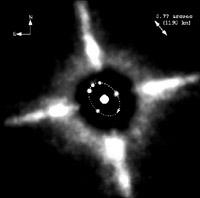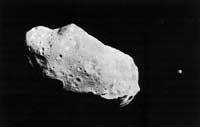Asteroid moons
2000/01/01 Elhuyar Zientzia Iturria: Elhuyar aldizkaria

The Kanada-France-Hawaii (CFHT) telescope, thanks to a new technique, has observed a smaller asteroid rotating around the asteroid Eugenia. It is located at 1.190 km and forms circular orbits of 5 days of duration. The diameter of Eugenia is 215 km and that of its satellite of about 13 km. To date, astronomers only found a couple of asteroids, the asteroids Ida and Dactyl.
The discovery was made in 1993 and since then all attempts to observe more couples have failed. It has been possible to measure the influence of Eugenia's gravity on its moon and calculate the mass of the asteroid Eugenia. It is not possible to calculate the mass of asteroids without moon, so it is so important the discovery made, since it provides us with a method to know the mass of asteroids. As the size of Eugenia was already known, it is easy to calculate the density by measuring the mass.
Density is a data of great importance in the research of asteroids, whose knowledge allows researchers to know the composition and formation of the asteroid. Thus, it has been proven that the density of Eugenia is 20% higher than that of water, from which it follows that the asteroid is formed by ice or very porous rock.
The discovery is the first result of the 200 asteroid observation program that astronomers expect to find more pairs.

Gai honi buruzko eduki gehiago
Elhuyarrek garatutako teknologia




